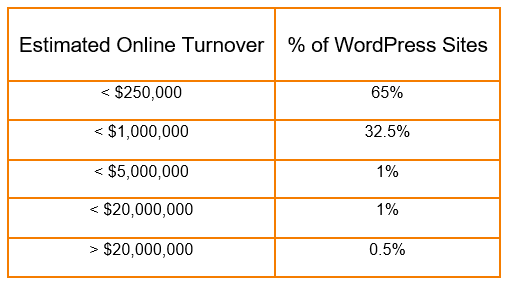
Gold in the Emerge-Tech Category!
24/08/2021
WordPress and eCommerce are in a settled state of matrimony. This post explores how that happened, and reveals some interesting insights about the eCommerce merchants who are currently sitting on WordPress platforms. We also provide some tips on how to get started when deciding on an eCommerce platform for your website. Read on to find out!
The Rise of WordPress
Like it or loathe it, WordPress is one of the world’s most popular blogging platforms and is likely to remain so for the foreseeable future. It is one of the easiest platforms for any non-technically minded individual to get started on the web. Such is its popularity, that various reports estimate that it powers around 25% of all websites in the world today. This makes sense, considering that it’s easy to install, quick to set up, and just for good measure, it’s also free.
When it started to gain rapid growth in popularity from around 2004, the creation of third party plugins and extensions greatly enhanced the WordPress potential. No longer was one confined to using it for blogging or content management. WordPress was now being used extensively for corporate websites, news websites, photo galleries, and probably any other use-case you can think of. There were few areas that it could not serve, and eCommerce was no exception.
eCommerce Technology for WordPress
At TAMI, we currently track 9 WordPress eCommerce plugins:
- Cart66 (For word press)
- Ecwid Shopping Widget
- eShop for WordPress
- JigoShop
- Shopp
- WooCommerce for WordPress
- WordPress Checkout
- WordPress eStore Plugin
18% of sites we have tracked to date are using one of the above platforms, meaning that they ‘sit’ on WordPress. But of these, there is one clear winner: WooCommerce is used by 86% of eCommerce sites sitting on WordPress. Following this is WP eCommerce and Ecwid (both hovering around 4.5%), and WordPress eStore Plugin with 1.8%. The remaining platforms make up the tiny numbers.
WordPress Sites With eCommerce Functionality?
When I began coding the algorithms for TAMI, the popularity of WordPress platforms became apparent after scanning about 1 million websites. Fast-forward a few months to the point when I had analysed about 100 million websites. This exposed one of the greatest challenges in putting some truth on the numbers when it comes to analysing the eCommerce technology landscape: WooCommerce threw the highest number of ‘false positives’. By this, I mean that a huge number of websites have the WooCommerce plugin enabled. However, hundreds of thousands, or possibly millions of these sites do not actually sell anything. Therefore, I couldn’t legitimately categorise these as ‘eCommerce.’ Removing this ‘noise’ from our dataset is an ongoing challenge.
Our code also goes a bit deeper than merely acknowledging that a website uses WooCommerce. We look for evidence that the site is genuinely trading online. So, when you see statistics claiming that WooCommerce is active on over 1.5 million sites, be wary. The reality is that roughly only a quarter of these are selling something online. We can call the rest ‘e-commerce enabled.’
Merchant Size & WordPress
This is where things get interesting. Based on some of the key data points that we display on our lead generation tool (i.e. Estimated Online Turnover), we uncovered some interesting insights:
if a site is using a WordPress plugin for its eCommerce operations, there is a 97% chance that it falls into one of the ‘small merchant’ turnover brackets (annual online turnover of less than $1 million). And remember, small merchants have less web traffic. This strongly correlates with the opinion of many technologists: the busier your site, the less likely you are going to be sitting on a platform like WordPress. From a technical standpoint, this is mainly due to constraints around flexibility and scalability.

Many websites within this 97% bracket would suffer very slow response times on their existing hardware if they were to have the gratifying problem of becoming ‘too busy’, and generating a higher turnover! Also, think about the implementation of complex code to deal with special offers, referral logic, or specific customer journeys for certain types of products. When a merchant is successful enough to handle tens of thousands of products, integrate with several payment gateways and shipping companies, it might be more sensible to choose a more robust platform such as
Magento Enterprise. If you can afford it and have sufficient turnover and user traffic, then look towards the higher end of the market, such as ATG Web Commerce, IBM Websphere or Demandware…just to name a few.
Ideal for Getting Started
If you’re starting from scratch, don’t want to pay a monthly fee to one of the many new SaaS eCommerce platforms out there, and you are happy to run your site with a few hundred products for under $100 a year, then any of the WordPress extensions are an option for you. Uploading your first product and accepting a payment is literally no more difficult than sending an email. However, if you need to prepare for rapid growth and a very high number of concurrent users, consider one of the more robust platforms out there as mentioned above.









